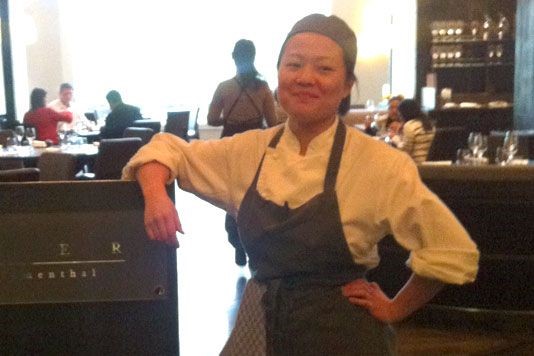Tips from the professional kitchen

Qin Xie shares tips she learnt as a stagiaire in the kitchens of Roganic and Dinner by Heston Blumenthal
Easter break – that nice little interlude between winter and spring. Some people catch the last of the ski season while others over-indulge on chocolate. I spent mine working in the kitchens of Roganic and Dinner by Heston Blumenthal as a stagiaire. It's probably not the most orthodox way of spending your holidays but as a Diploma student at Leiths School of Food and Wine, I needed to do some work experience and where better than at two of the most avant garde restaurants in London?
Just a few tips...
I did my share of veg peeling, of course, but was also surprised to find myself in charge of some of the puddings at Roganic and plating up starters at Dinner by the end of the week. As well as getting to do some unusual things like picking snails and making meat fruit, I picked up some great tips too.
Uniform dice
 Whatever kitchen section you're on, you will inevitably find yourself having to dice something to perfection. If you hold the knife at the base of the blade, you have a greater handle on where the blade is going – especially if you have a disproportionately large knife to your small hand.
Whatever kitchen section you're on, you will inevitably find yourself having to dice something to perfection. If you hold the knife at the base of the blade, you have a greater handle on where the blade is going – especially if you have a disproportionately large knife to your small hand.

Always cut square into uniform and manageable batons first. Have the vegetable horizontal to you with the knife perpendicular, so it's easy to judge the size by eye, and then push the blade through in a roll/slice motion.
Turning vegetables
 Turned vegetables are a classically French accompaniment to dishes. At Roganic, cauliflowers are turned and then pickled to dress the plate. The idea of a turned cauliflower is to produce a perfect round button so you need to break up the florets first.
Turned vegetables are a classically French accompaniment to dishes. At Roganic, cauliflowers are turned and then pickled to dress the plate. The idea of a turned cauliflower is to produce a perfect round button so you need to break up the florets first.

You only need half a centimetre of the white stalk on each floret so it's easier to trim the florets and then turn it as the smaller bits will just fall away on their own. Using a turning knife, carefully pull the blade through the cauliflower towards you while rotating the floret. Aim the blade towards the outer edge of your thumb and you'll be less likely to cut yourself.
Perfect pane
 Pane (pronounced pan-nay) is the process you go through to make chicken nuggets, fish goujons or the balls of sweetbread at Dinner. It can get very messy! The best way to pane without clumps is to use one hand for the dry ingredients and one for the wet, with the flour, egg wash and breadcrumbs in three separate bowls.
Pane (pronounced pan-nay) is the process you go through to make chicken nuggets, fish goujons or the balls of sweetbread at Dinner. It can get very messy! The best way to pane without clumps is to use one hand for the dry ingredients and one for the wet, with the flour, egg wash and breadcrumbs in three separate bowls.
Use your 'dry' hand to dip whatever you're paneing into the flour first to absorb any surface moisture. Gently bounce it between the palms of your hand to dust off the excess before dropping it into the egg wash to be completely coated. Pick it up with your 'wet' hand and drop it into the breadcrumbs and coat using your 'dry' hand. Once it's completely coated in breadcrumbs, bounce it between the palms of your hand again to get rid of the excess breadcrumbs.
Looking for more great kitchen tips?
Anjali Pathak shares her Indian cooking
Comments
Do you want to comment on this article? You need to be signed in for this feature